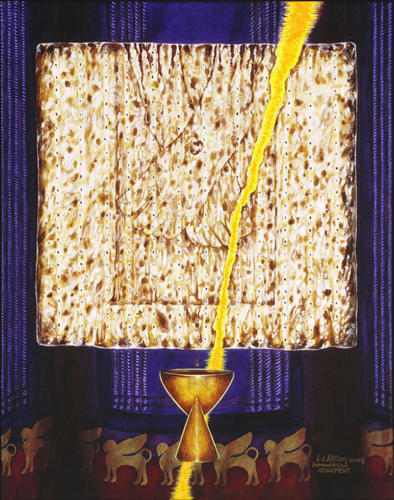| |Home |
|Subscribe |
|Donate |
|Join |
|About |
|Contact |
||

exhibiting artists
Ken Arnold
Roger Beattie
Kathrin Burleson
Mary Anne Carley
Dennis Di Vicenzo
Lorna Effler
Paul Fromberg
Susan Goff
Janice Holman
Moses Hoskins
Ann Kim
Judy Gibson King
Audrey Lee
Mary Mayer
Nicole Maynard
Judith McManis
Zachary Roesemann
Claudia Smith
Patricia Smith
Kathy Thaden
Susan Tilt
Barbi Tinder
Vanessa Wells
Jeff Wunrow
 |
Atonement |
| Atonement: reconciliation, at-one-ment:
the state of being at one or being reconciled… the effect
which flows from the death of Christ. Artist Interpretation: This painting depicts our atonement with God through Jesus Christ. When we look at the painting, immediately our eyes are drawn to the large square. This image represents the body of Christ the bread from Heaven…broken for us. Leaven makes dough rise; in Scripture it’s symbolic of sin. Here we see flat, unleavened bread, for Christ was sinless. Holes are pierced through the bread. Christ was pierced. From baking we see a pattern of stripes on the bread. This was prophesied in Scripture: “But He was wounded for our transgressions, He was bruised for our inequities…and by His stripes, we are healed” Isaiah 53: 5. In the middle of the bread we see a formation of feet nailed to a cross—Jesus crucified. Gaze downward and see blood droplets dripping into a cup. This represents THE BLOOD of Christ, the cup of our salvation. Jesus was the sacrificial Lamb of God. Sacrifice: a priceless value given up to appease God. During Passover the Hebrew’s celebrate their redemption from slavery in Egypt…God set them free. Protected from the “judgment of Jehovah”, the children of God were identified by the blood of an innocent lamb sprinkled around their door. The Lord would “passover” their household. No longer are animal sacrifices needed: Jesus is our Passover lamb. Through Christ’s sacrifice, we are all redeemed by the pure sacrificial blood of the Lamb of God. With the bread (body of Christ) and the blood we have a “marriage” between Passover and the Lord’s Supper—both symbolic of love, sacrifice, and redemption. However, Christ has reconciled us in His fleshly body through death, to present us before God holy, blameless and beyond reproach. Holy of Holies: The innermost sanctuary of the Temple associated with the radiant presence of God. In the background is a rendering of the thick curtain that secluded this room. The curtain represented a separation between God and man. No one could enter this room except the High Priest: once a year on the Day of Atonement he would go before the Lord. He would come with innocent blood of an animal sacrifice, and beg forgiveness for man’s sin. For Scripture teaches atonement is only in the blood, Leviticus 17:11. The death of Christ was a sacrifice of infinite worth, one that brought man back into “right relationship” with God and the promise of eternal inheritance. When Jesus offered His sinless blood…the curtain of the Temple was torn in two. Shown in the painting, the bread is broken, the curtain is torn…the sacrifice of Jesus’ body and blood has opened the way for us into the Holy of Holies. Bursting forth from behind the veil is the brilliant presence of God. His sacrifice…our Day of Atonement with God! Follow the blood droplets, look closely and you’ll see Satan screaming, for the battle is over and the victory is won. Jesus our Saviour is Lord! Community: Grace Episcopal Church, Ocala, Florida Email: efflerart@aol.com Website: www.revelationart.org |
